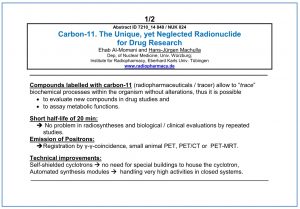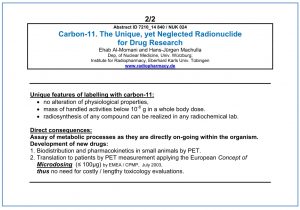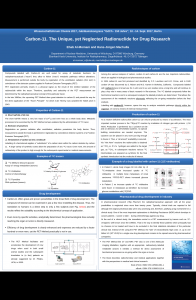Carbon-11 is a really unique radionuclide, well suited for studies in lifesciences and, in particular, drug development, yet it is completely neglected.
Author Archives: machulla
Drug development and carbon-11
| At the meeting of the German Society of Chemistry (Gesellschaft Deutscher Chemiker [GdCh]) in Berlin from 10 to 14 September 2017, Ehab Al-Momani and I will present a poster about the unique role of Carbon-11 in drug research, as it is practically completely neglected on the international level.
The poster will be introduced in a session by two slides emphasizing the properties of carbon-11 founding the unique features of this radionuclide in the field of drug development. You can download the poster and the slides (PDF) from the link below or by clicking on the images to the left. |
|
|
| |
|
|
Control of cancer therapy by PET

The image shows the strategy of applying PET in cancer therapy.
The PET method provides a stategy to a direct control of therapy on-going in the patients. After three weeks PET is repeated and may show success of therapy in case of a responder. If no effect is seen, therapy is stopped and strategy of treatment is changed.
Read more about this in the book (chapter 4.1).
Welcome
 It is the aim of the Web Site to discuss and present on-going aspects and developments in Radiopharmacy by Hans-Jürgen Machulla, PhD, University Professor for Radiopharmacy at the Eberhard Karls University Tübingen. In Europe, it was the first Professor position for the field and supported by the Volkswagen Foundation financially for cyclotron, radioanalytic equipment and technical staff positions. In addition, building for cyclotron, radiochemical laboratories and PET scanner were funded by the State of Baden-Württemberg and the University. In 1992, the PET Center started with development, evaluation and routine production (GMP) of radiopharmaceuticals for direct clinical applications.
It is the aim of the Web Site to discuss and present on-going aspects and developments in Radiopharmacy by Hans-Jürgen Machulla, PhD, University Professor for Radiopharmacy at the Eberhard Karls University Tübingen. In Europe, it was the first Professor position for the field and supported by the Volkswagen Foundation financially for cyclotron, radioanalytic equipment and technical staff positions. In addition, building for cyclotron, radiochemical laboratories and PET scanner were funded by the State of Baden-Württemberg and the University. In 1992, the PET Center started with development, evaluation and routine production (GMP) of radiopharmaceuticals for direct clinical applications.
This site is to give an introduction into the field and, most importantly, will emphasize recent developments and perspectives in the medical application of various radiopharmaceuticals used as tracers in diagnostics and therapy.
Applications in medicine
The registration of biochemical processes directly within the organism makes the PET method a versatile tool for studying metabolic functions in both research and diagnostic examinations. Control of therapy is realized by directly analyzing corresponding metabolic alterations and, thus, in case of lacking response the reporting strategy can be changed immediately. That holds for oncological and neuropsychiatric diseases.
Moreover, the possibility of the direct transfer from the in-vitro to the in-vivo level allows the translation from the static to the dynamic biological system and exhibits a key feature in the PET method for drug development. Yet, the approach is rarely used during the past twenty years and the “tail” of extraordinarily high cost of a drug development keep to be spread around. With the PET method the promise of a new compound is seen in a study within a few mice modeling the particular disease. Even more, those data allow a direct translation to the clinical level with a few patients only.
Labeling with radiometals or Al18F2+
Radiometalation by gallium-68, copper-64 or zirconium-89 in chelating complexes attached to peptides or proteins make use of high specificity and selectivity of those compounds with the outstanding advantage of application in therapy just by taking a different radionuclide appropriate for therapy such as yttrium- 90 or Lutetium-177.
A recent very important alternative is the labeling with Al18F2+. The surprising feature is the fact that this compound was found to exhibit the property of a radiometal. Therefore, the advantages of fluorine-18 longer half-life (110 min) instead of 68 min in case of gallium, lower positron energy (0.65 MeV vs. 1.9 MeV (68Ga)) resulting in best imaging quality are combined with those of complex formation which keeps the alternative application for therapeutic use by using a different radionuclide. Continue reading
Radiopharmaceutical concepts
PET primarily registers a physical signal originated by the tracer (radiopharmaceutical) and thus the PET signal is directly correlated by the biochemical concept of the tracer for assessment of the particular metabolism. Therefore, specificity and selectivity of the particular PET measurement are directly defined by the tracer. The concepts of metabolic trapping and metabolic blocking allow the external examination of metabolic processes.
The Tracer Principle
In general, radiopharmacy is the approach to prepare compounds for direct application of the Tracer Principle on the in-vivo level both in experimental research and clinical diagnostics.
Due to the short half-lives, compounds labeled with PET radionuclides (“tracers”) have very low mass such as 10-6 g or even less as it is administered in a whole body dose. Therefore, those tracers allow to “trace” the biochemical processes of interest directly with organism without any alteration.
Radionuclides
For PET radiopharmaceuticals the important prerequisite is the availability of suiatable radionuclides, mainly with short half-lives and emission of positrons. That allows imaging by registration of the gamma radiation (annihilisation) in coincidence i.e one detector registeres a signal only when an opposite one also gets one signal.
Prooduction of the radionuclides is performed by cyclotrons. Important nuclides are 15O, 13N, 11C and 18F 18 with half-lives of 2 min, 10 min, 20 min and 110 min, respectively, In subsequent radiosyntheses by use of automatic modules the compounds (radiopharmaceuticals are prepared for clinical administrations).
In contrast to the past, technical improvements allow installations of facilities for productions, radiosynthesis, and quality control in any building without special constructed buildings.
What is radiopharmacy?
It is the aim of this site to provide insights into the science of radiopharmacy and its fields of application in a medical context. You will also find information on the properties of radionucleides, Positron Emission Tomography (PET) and the tracer principle.
The field of radiopharmacy is dealing with development and final production (GMP) of radioactively labeled compounds for application in diagnosis and therapy. Those compounds allow to assess metabolic processes. By using Single-Photon-Emission-Tomography (SPECT) and, most importantly, Positron-Emission-Tomography (PET) metabolic functions are analyzed by registration outside of the body. That approach is of particular interest since it gives the possibility of using small molecules as radiopharmaceuticals. Thus, it is possible to analyze essential metabolic functions such as metabolism of glucose (energy supply), amino acids (protein synthesis) or neurotransmitters (receptor binding).


